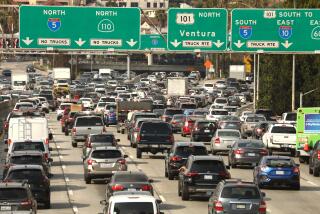Data Used in Smog War Challenged
- Share via
In a report questioning two decades of air pollution regulations, the National Academy of Sciences said Friday that the nation may be losing the war against smog because of “misdirected” efforts based on flawed information.
Reports of improved air quality during the last several years were overly optimistic, the academy concluded in a report to be delivered to Congress next week.
The regulations, which have cost billions of dollars over the last 20 years, were largely based on an underestimation of the pollutants from cars and factories. Regulators also failed to control nitrogen oxides, one of the two chief chemical ingredients of urban smog.
“Despite more than two decades of massive and costly efforts to bring (smog) levels under control, there’s been a lack of progress in many areas of the country. That’s both disappointing and perplexing,” said John H. Seinfeld, a Caltech professor who led the research effort. He said the misguided efforts may explain why so few cities have managed to meet federal clean air standards.
In California, the nation’s smoggiest state, air quality officials said the criticisms came as no surprise and noted that they had already been addressing many of the report’s concerns.
“The South Coast Air Quality Management District and the (state Air Resources Board) are certainly at the forefront nationwide,” Seinfeld said. But, he added, there are still problems with California’s clean air efforts.
In the Los Angeles region, for example, hydrocarbon emissions from motor vehicles are two to four times higher than officials had estimated, the researchers said.
Further, California’s “Smog Check” program is not as effective as the state had asserted. Coincidentally, a state Senate hearing on the issue is scheduled for next week.
Academy researchers also said that cleaner alternative fuels such as methanol may provide considerably fewer air quality benefits than some air quality regulators had projected.
The report, ordered by Congress, is certain to increase pressure on the U.S. Environmental Protection Agency for a major overhaul of its anti-smog strategy, especially outside California.
Nationwide, 67 million people live in areas exceeding federal clean air standards, based on 1989 estimates. Ozone, the prime ingredient of smog, reduces lung capacity, affects the body’s immune system and contributes to respiratory disease. Ozone is a toxic pollutant at ground level but at high altitudes protects the Earth from the harmful ultraviolet rays of the sun.
Hydrocarbons and nitrogen oxides are the two chemicals that form ozone in the presence of sunlight. Of the two, the academy said, far more controls must be placed on nitrogen oxides. Researchers said most efforts were misdirected by targeting hydrocarbons alone.
For years, it was assumed that most of the smog problem would be solved by controlling hydrocarbons, which include fumes from unburned gasoline and paint. But that approach was based on calculations that concentrations of hydrocarbons were 10 times higher than nitrogen oxides. Given that ratio, controlling hydrocarbons made sense, the scientists said.
However, the academy researchers concluded that hydrocarbon levels may be at least 20 times as high. Oddly enough, because of a complex set of chemical reactions, that means that smog control efforts should have been focused on nitrogen oxides.
In recent years, Southern California air quality regulators have begun to crack down on nitrogen oxides, which are produced whenever fuel is burned. The biggest contributors of this pollutant include oil refineries, electrical utilities and motor vehicles.
Researchers said that by changing the regulatory strategy, more air pollution reductions can be achieved at the same overall cost.
“I think the impact could be considerable,” said James M. Lents, executive officer of the AQMD. “The EPA doesn’t have a clear (nitrogen oxides) control policy with respect to ozone.”
But, based on California’s experience, any effort to shift course nationally is likely to generate strong opposition from industry, which would probably see its pollution control costs increase.
Among other findings, the academy also concluded:
* Reports that ozone levels are declining nationwide are based on unreliable measurements that may reflect weather conditions as much as smog controls.
* Hydrocarbons nationwide may have been underestimated in part because regulators overlooked natural emissions of the pollutant from vegetation. The AQMD is studying the phenomenon.
More to Read
Sign up for Essential California
The most important California stories and recommendations in your inbox every morning.
You may occasionally receive promotional content from the Los Angeles Times.










